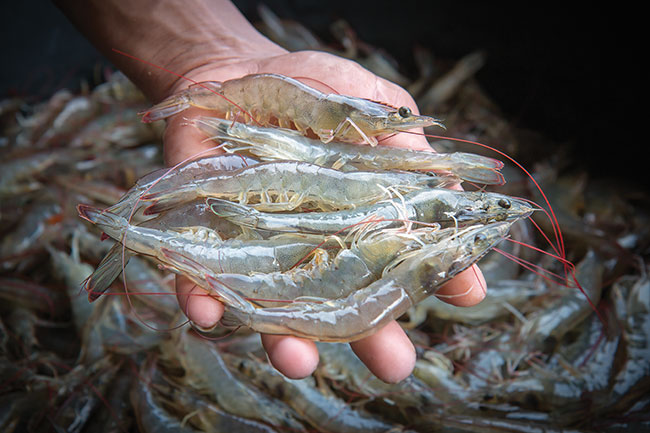
The future of shrimp feeding in ponds
July 19, 2023
By Magida Tabbara
Eavesdropping on animals has unexpected benefits
 Photo: © weerasreesam / Adobe Stock
Photo: © weerasreesam / Adobe Stock Pacific white-leg shrimp is recently stealing the spotlight as top-most aquacultured species in the world with over 5.8 million tonnes produced in 2020. Driven by the increasing demand for shrimp, worldwide shrimp production is expected to increase by 5.3 percent between 2022 and 2030.
Several factors played a role in improving shrimp production over the years, from increasing the production areas to intensifying production with supplemented aeration, in addition to providing the animals with nutritionally adequate feed and having proper feed administration.
Shrimp is a very popular seafood commodity in the United States. Average shrimp consumption per capita reached five pounds in 2020, mainly due to the multiple health benefits that eating shrimp provides. The increased demand for shrimp is surely driving the production up. Nevertheless, multiple challenges impede further development.
Shrimp is fairly easy to raise. However, the production cost is quite expensive, mainly because of feeding activities and the labor associated with them. Thus, proper feed administration, with minimum wastage and labor intervention, is therefore key for realizing good profit.
Traditional vs modern shrimp feeding techniques
Feed and feeding activities account for the majority of aquaculture production expenses. Traditionally, feed input in the ponds was estimated by looking back at historical data from the same farm or using feed trays to assess feed consumption. Feed trays were proven to be beneficial in reducing feed wastage. However, the labor involved in checking up on the feed trays tends to outbalance the production benefits, especially in countries like the U.S. where labor wages are expensive.
Recent studies suggest that increasing the number of feedings per day helps increase shrimp size and yield, and hence economic returns. It was proven that offering shrimp six feedings per day instead of the traditional two feedings significantly increases growth. The idea is that shrimp are slow bottom feeders with very short intestinal tracts. The more feedings are provided, the more the shrimp can benefit from the nutrients in the feed offered. As the feed pellets spend less time in the water, less nutrients leach out, and the nutritional value of the feed is conserved. Unfortunately, increasing the number of feedings per day does not mitigate overfeeding and labor cost.
Automatic feeders were put into practice to allow the shrimp to have several meals a day with less labor involved. Nevertheless, the problem of overfeeding persists: observing shrimp feeding in ponds is almost impossible and the animals are unfortunately not in the habit of notifying us when they’re hungry!
Unexpected benefits of eavesdropping
While it’s true that observing shrimp feeding in the pond is nigh impossible, “eavesdropping” on the animals can be easily done. Passive acoustic monitoring or PAM is a novel technology that allows for monitoring wildlife using acoustic sensors and recording of sound waves. The technique is non-invasive and relies mainly on dropping a hydrophone in the water and recording audible signals. Shrimp are sloppy eaters by nature and make noises while chewing their feed, which makes it easy to use PAM to monitor their feeding behavior.
Shrimp work on reducing the size of the feed pellet through external mastication using their mandibles on the feed particle prior to ingesting it. Mandibular occlusion during feed mastication results in the production of a “clicking” sound. With all of that occurring in saltwater, acoustic signals from the “clicks” rapidly and efficiently find their way to the hydrophones in the water. The “clicks” are then converted to electrical signals, which can be processed instantaneously or even recorded for research purposes. Because the “clicks” are a result of mastication activity, they directly correlate with feed intake. Thus, hydrophones are linked to automated feeding systems in ponds to provide the shrimp with feed “on-demand”.
“On-demand” feeding shows promising production results
“On-demand” acoustic feeding in pond settings is showing promising production results. Research published in 2021 by a team of researchers from Auburn University demonstrated that around 800 kg of shrimp were produced in a 0.1 hectare pond using on demand acoustic feeding. The authors compared shrimp yield from those ponds and from other ponds offered the same feed but using automatic feeders and realized an increase in shrimp yield by 200 kg per pond just by employing acoustic feeders! Shrimp produced in ponds employing acoustic feeders were valued at nearly US$40,000 per hectare, compared to US$27,000 to 32,000 per hectare for shrimp in ponds relying on traditional automatic feeders.
Advertisement
The acoustic feeders enable the shrimp to have access to feed 24 hours a day, which serves the biological need of the shrimp for multiple feedings a day. As to feed wastage concerns, data from the same study indicated that FCR was very close to one, which implies that all of the feed was efficiently used in growth. Feeders are filled once or twice a day, so no additional labor is needed.
Feeding automation has helped aquaculture flourish in the past two decades. “On-demand” acoustic feeders represent the future of shrimp production in ponds for their multiple economic benefits. Employment of this modern technology cuts back the duration of the production cycle by inducing fast growth and bigger yield of high value shrimp. Current use of acoustic feeders depends mainly on passive acoustic monitoring. There is definitely potential for employing artificial intelligence driven active acoustic feedings to further improve shrimp production in the near future.
- Akvafuture brings closed barrier tech to Canada
- Innovasea hires veteran farm operator as aquaculture services lead





